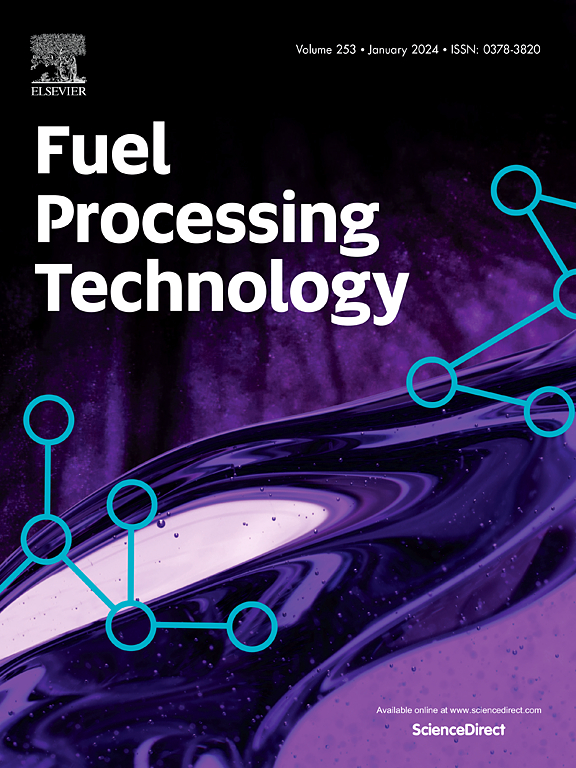Effect of ammonia concentration on emulsification characteristics of ammonia solution–biodiesel emulsion blends
IF 7.2
2区 工程技术
Q1 CHEMISTRY, APPLIED
引用次数: 0
Abstract
Emulsifying ammonia in biodiesel provides an eco-friendly fuel for diesel engines by reducing NOx emissions. Research on this emulsification for diesel engines is still in its early stages with limited studies available. The characteristics of ABEF at various ammonia concentrations are unknown. Understanding these characteristics is critical to optimizing incorporation strategies of optimum ammonia concentration. This study examined ABEF behavior with ammonia concentrations of 1, 3, 5, 7, and 10 wt% of water content. We evaluated MDD, emulsion stability, DPA, and pH changes. Emulsions were prepared by mixing cooking oil biodiesel, water, ammonia solution, and surfactants using an ultrasonic homogenizer. Through the preliminary tests, we determined that the sonication for 10 min with 0.5 vol% surfactant and 10 vol% water achieved the best emulsion properties for ABEF. The results show that MDD in ABEF increased with ammonia concentration of up to 5 wt% but decreased above 10 wt%. The DPA also increased with ammonia concentration, reaching 2.85 % at 10 wt% compared with 2.52 % in the biodiesel emulsion without ammonia. Increased ammonia concentration increased pH, improving surfactant performance and emulsification stability. Emulsions with 5–10 wt% ammonia were more stable than those with 1–3 wt% due to stronger repulsive forces preventing droplet fusion.
氨浓度对氨溶液-生物柴油乳液共混物乳化特性的影响
生物柴油中的乳化氨通过减少氮氧化物排放为柴油发动机提供了一种环保燃料。对柴油机的这种乳化作用的研究还处于初级阶段,研究成果有限。不同氨浓度下ABEF的特性尚不清楚。了解这些特性对于优化最佳氨浓度的掺入策略至关重要。本研究检测了ABEF在氨浓度为1、3、5、7和10 wt%含水量时的行为。我们评估了MDD、乳液稳定性、DPA和pH变化。用超声波均质机将食用油、生物柴油、水、氨溶液和表面活性剂混合制备乳剂。通过初步试验,我们确定以0.5 vol%的表面活性剂和10 vol%的水超声10 min后,ABEF的乳化性能最佳。结果表明,当氨浓度达到5 wt%时,ABEF中的MDD增加,但超过10 wt%时,MDD下降。DPA也随着氨浓度的增加而增加,在10 wt%时达到2.85%,而在无氨的生物柴油乳液中为2.52%。氨水浓度增加,pH值升高,表面活性剂性能改善,乳化稳定性提高。含有5-10 wt%氨水的乳剂比含有1-3 wt%氨水的乳剂更稳定,这是由于更强的排斥力阻止了液滴的融合。
本文章由计算机程序翻译,如有差异,请以英文原文为准。
求助全文
约1分钟内获得全文
求助全文
来源期刊

Fuel Processing Technology
工程技术-工程:化工
CiteScore
13.20
自引率
9.30%
发文量
398
审稿时长
26 days
期刊介绍:
Fuel Processing Technology (FPT) deals with the scientific and technological aspects of converting fossil and renewable resources to clean fuels, value-added chemicals, fuel-related advanced carbon materials and by-products. In addition to the traditional non-nuclear fossil fuels, biomass and wastes, papers on the integration of renewables such as solar and wind energy and energy storage into the fuel processing processes, as well as papers on the production and conversion of non-carbon-containing fuels such as hydrogen and ammonia, are also welcome. While chemical conversion is emphasized, papers on advanced physical conversion processes are also considered for publication in FPT. Papers on the fundamental aspects of fuel structure and properties will also be considered.
 求助内容:
求助内容: 应助结果提醒方式:
应助结果提醒方式:


